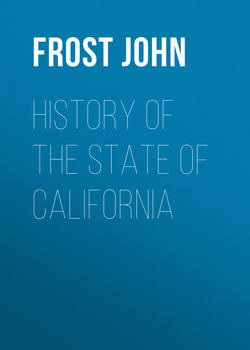History of the State of California

Реклама. ООО «ЛитРес», ИНН: 7719571260.
Оглавление
Frost John. History of the State of California
PREFACE
CHAPTER I
CHAPTER II
CHAPTER III
CHAPTER IV
CHAPTER V
CHAPTER VI
CHAPTER VII
CHAPTER VIII
CHAPTER IX
CHAPTER X
CHAPTER XI
CHAPTER XII
CHAPTER XIII
CHAPTER XIV
CHAPTER XV
CHAPTER XVI
APPENDIX
Appendix A
B
C
D
E
Appendix F
Appendix G
H
Appendix I
Appendix J
Appendix L
Appendix M
Отрывок из книги
The territory called California is that part of North America situated on the Pacific Ocean, and extending from the 42° of north latitude southwardly to 22° 48', and from 107° longitude, west from Greenwich, to 124°. It is bounded on the north by Oregon territory, east by territories belonging to the United States and the Gulf of California, and on the south and west by Mexico and the Pacific Ocean. California is naturally divided into two portions; the peninsula, called Lower California, and the territory extending northward from the peninsula, on the Pacific Ocean, called Upper California. The line of division between Upper and Lower California runs nearly along the 32d parallel of latitude, westward from the head of the Gulf of California.
The peninsula of California is about one hundred and thirty miles in breadth, where it joins the continent. It extends south-eastwardly, generally diminishing in breadth, till it terminates in two points. The point farthest south-west is called Cape San Lucas. The other, sixty miles east by north of San Lucas, is called Cape Palmo. The peninsula is about seven hundred miles long.
.....
"The gold 'placer' near the mission of San Fernando has long been known, but has been little wrought for want of water. This is a spur which puts off from the Sierra Nevada (see Fremont's map,) the same in which the present mines occur. There is, therefore, every reason to believe, that in the intervening spaces, of five hundred miles (entirely unexplored) there must be many hidden and rich deposits. The 'placer' gold is now substituted as the currency of this country; in trade it passes freely at $16 per ounce; as an article of commerce its value is not yet fixed. The only purchase I made was of the specimen No. 7, which I got of Mr. Neligh at $12 the ounce. That is about the present cash value in the country, although it has been sold for less. The great demand for goods and provisions, made by this sudden development of wealth, has increased the amount of commerce at San Francisco very much, and it will continue to increase."
The Californian, published at San Francisco on the 14th of August, furnishes the following interesting account of the Gold Region:
.....